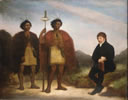The second set of big ideas from the west were those of Christianity. With the arrival of Samuel Marsden in 1814, the country became a site for the propagation by missionaries of the Christian faith. Christianity became an important force in New Zealand for the next 200 years. New Zealand has not been a significant site of new Christian ideas, with the exception of some new forms of Māori religion and the occasional lone theologian like the late-20th-century radical thinker Lloyd Geering.
The beauty of science
At the end of his life William Colenso explained his love of science and its relationship to religion: ‘There is a joy in contemplating the manifold forms in which the All-beautiful has concealed His essence – the living garment in which the Invisible has robed his mysterious loveliness.’1
Missionary scientists
Missionaries did contribute significant ideas in other fields besides theology. William Colenso and Richard Taylor were important early recorders of the geology and natural history of New Zealand. They saw science as unfolding the beauty of God’s creation.
Missionary ideas of race
Missionaries also added to the debate about the nature of Māori. Initially they came with the simple view that Māori were depraved and barbaric and had to be brought into civilisation. Thomas Kendall accepted that Māori, like all people, were predestined to damnation, but could be saved from damnation by being ‘twice-born’ through Christ. Drawing on the Encyclopedia Britannica, he claimed that Māori must have originally been Egyptian.
Most early missionaries drew on the biblical idea that all peoples were descended from Noah’s sons after the Great Flood. They argued that Europeans were descended from Noah’s oldest son, Jephet, and supposedly primitive people like Africans and Aborigines from the youngest son, Ham, but Polynesians (like Indians) descended from the middle son, Shem. Samuel Marsden suggested that Māori were indeed semitic (sons of Shem) on the basis of what he saw as their Jewish characteristics.
Who were the savages?
After the Taranaki war broke out in 1860, Richard Taylor attended a meeting at Pūtiki, where Māori expressed their loyalty to the Crown. He then went on to another meeting with settlers, many of whom were drunk. Taylor wrote that ‘one was a meeting of gentleman savages, the other of savage gentlemen’2.
Later some Māori, such as the prophets Te Ua Haumēne, Te Kooti Arikirangi and Te Whiti-o-Rongomai, drew on this idea to liken Māori in New Zealand to Jews fleeing captivity in Egypt.
The missionary Richard Taylor also believed that Māori were one of the lost tribes of Israel. He adjusted his initial thoughts contrasting savage Māori with civilised Europeans, and decided that they were indeed a noble people.









